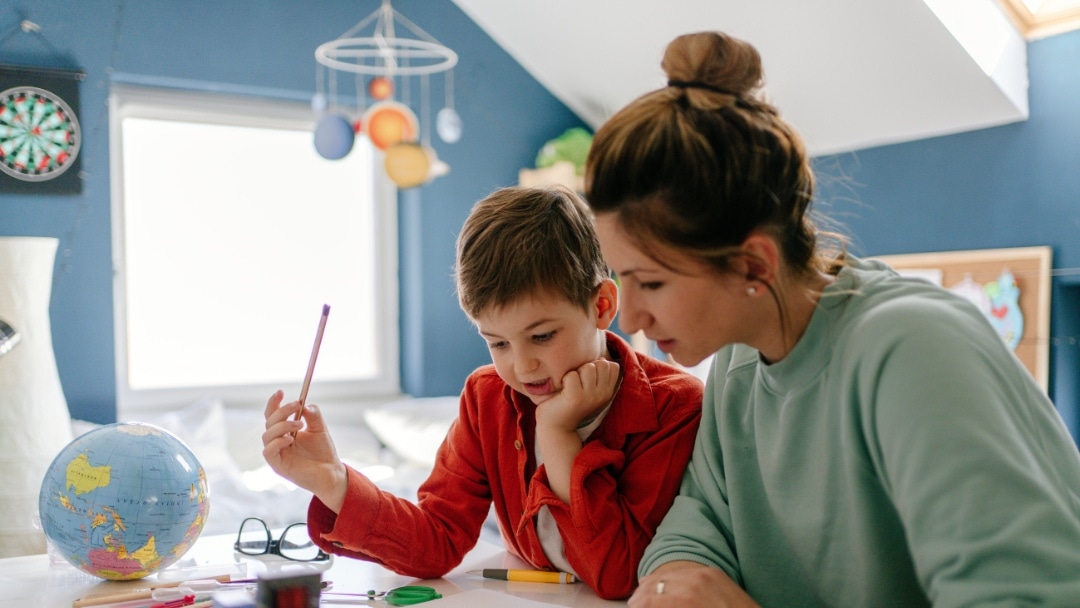In this blog post, Cindy Rinaldi tells her story of homeschooling special needs children.
When we withdrew our children from the local Catholic school for homeschooling special needs children, people figured we were crazy. Many folks know the struggle we had been through, since three of our four kids had been diagnosed with visual perception problems. Between vision therapy, academic remediation, and long nights crying over homework, we were swamped!
The decision to homeschool our eldest, now 12, was agonizing. If you, too, are thinking that bailing out of the education maelstrom may be best for your special child, let me try to answer some of your questions.
Is It Legal?
Make sure your state has no regulations prohibiting you from home-schooling your special needs child. Homeschooling is legal in all 50 states and Canada, but in some states, specific regulations apply for special needs. (Ironically, you may not need permission if your child has severe visual perception problems, which are not under the “special ed” umbrella.)
Where Do You Find Textbooks?
Textbooks of every kind (Christian, secular, New Age, etc.) are available through a variety of distributors, including some home school “schools” that offer grading, report cards, record keeping, even diplomas!
What Is the Cost?
Costs can be nil (library-based curricula), to over $1,000 per child. Our yearly costs average about $100 per child, including texts (mostly used) and writing and art supplies.
Can You Teach Your Own Child?
Do your goals for your child include academic remediation and rebuilding self-esteem? Then, who better than you will strive to help your child succeed? To keep you on track, many text suppliers offer lesson plans and course syllabi. Many parents hire tutors for music, higher math, and other subjects they feel unable to teach.
What Is a Typical Day Like?
Our homeschool day is dissimilar from a regular school day, although we cover the same subjects, and more. Each morning, all four kids, plus the dog and I, begin around the dining room table.
Using the Saxon program, my oldest son completes two math lessons, reading, English, and science. I review main points with him, making corrections where necessary, but don’t lecture him. He is always responsible for his own work. He has no “homework,” but if he earns less than 90% or 95% on a test, he has not mastered the material, so we take extra time to review. (In school, he would get no review as long as he got 75%.)
I do not assign book reports since each week he devours a 400-page novel. We discuss plot, theme, and character development, and he writes synopses occasionally.
Social studies easily lends itself to “unschooling” teaching and learning without textbooks. Our frequent visits to historical sites reinforce his interest in maps and U.S. history.
My seven-year-old daughter does work to reinforce her visual and auditory/language processing skills. Much of her instruction uses a “hands-on,” kinesthetic approach, such as making letters and words with sand, foam blocks, paper, playdough, and spaghetti.
My twin boys, nine, do the three R’s through workbooks and regular texts. They read (voraciously); I teach (a little); they excel! Afternoons are spent on their own projects (an undersea world, Lego coal mine), with other homeschoolers fulfilling gym requirements, or in individual pursuits.
What About Socialization?
Socialization is often a reason to choose homeschooling. The inability to keep up academically or to read body language correctly, or just seeing the world through different-colored glasses can endanger a child’s peer relations. Homeschoolers enjoy many friendships with close-aged people with similar interests, who are not just thrown together by geography or birthdate.
Can You Do This Every Day?
Generally speaking, primary elementary work can be completed in three or fewer hours per day. Remedial work may be slow at first, but with individual attention and a hands-on approach, your child may complete whole grade levels in months – or weeks!
Every day is not bliss, and homeschooling certainly is not for everyone. I would like a neater house and more time for other pursuits. But for children who learn differently, this alternative offers the beauty of rewarding family interaction, one-on-one tutoring, increased self-esteem, and academic excellence – without the social insecurity often encountered at school. For us, homeschooling has been a blessing.
Still Looking for Answers?
Visit the Epidemic Answers Practitioner Directory to find a practitioner near you.
Join us inside our online membership community for parents, Healing Together, where you’ll find even more healing resources, expert guidance, and a community to support you every step of your child’s healing journey.
Sources & References
Duvall, S. F., Delquadri, J. C., & Ward, D. L. (2004). A Preliminary Investigation of the Effectiveness of Homeschool Instructional Environments for Students With Attention-Deficit/Hyperactivity Disorder. School Psychology Review, 33(1), 140–158.
Duvall, S. F., Ward, D. L., Delquadri, J. C., & Greenwood, C. R. (1997). An exploratory study of home school instructional environments and their effects on the basic skills of students with learning disabilities. Education and Treatment of Children, 20(2), 150–172.
Resources
Books
Cooper, Bruce. Homeschooling in Full View, a Reader. Greenwich, CT: Information Age Publishing, 2005.
Cooper, Bruce, et al. Homeschooling in New View. Greenwich, CT: Information Age Publishing, 2016.
Furth, Hans. Thinking Goes to School: Piaget’s Theory in Practice. Oxford University Press, 1975.
Websites
HSLDA (Home School Legal Defense Association)
NATHHAN (National Challenged Homeschoolers Associated Network)




